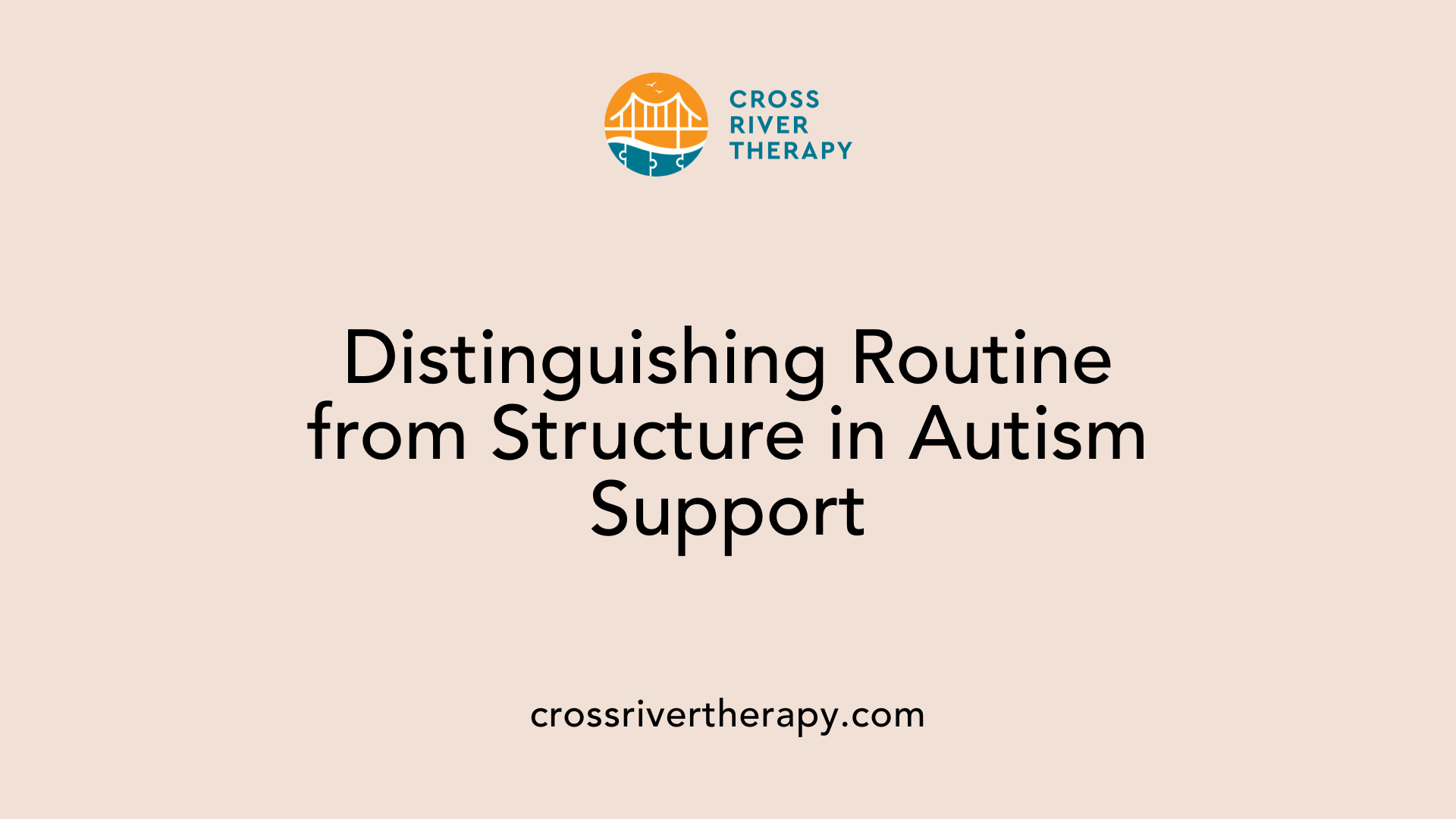Autism and the Importance of Structure
Creating Predictable and Supportive Environments for Autistic Individuals
The Role of Structure in Autism
For individuals with autism, the predictability and stability of structured environments cannot be overstated. These environments provide crucial support by reducing anxiety, enhancing communication, and facilitating daily functioning. Understanding the neuroanatomical basis of autism can inform how we design these environments, making them more accommodating and supportive.
The Benefits of Structure in Autism

Why is structure important in autism?
Structure plays a vital role in improving the lives of individuals with autism spectrum disorder (ASD). It provides the stability and predictability essential for emotional well-being. A consistent routine allows individuals to navigate their day more effectively, significantly reducing anxiety and creating a sense of security. When individuals know what to expect, they can feel more confident and less overwhelmed.
Impact on emotional well-being and communication
A predictable routine facilitates better communication and social interactions. Individuals with autism often benefit from visual supports, such as schedules and timers, which enhance their understanding of daily activities and help manage transitions smoothly. For example, a visual schedule can clarify what tasks are next, reinforcing expectations and diminishing uncertainty.
Incorporating flexibility into these routines is also beneficial. It allows individuals to adapt to changes while maintaining a sense of security. This structured yet adaptable approach encourages the development of self-regulation skills, fostering confidence and independence as individuals learn to manage changes in their environment.
| Benefit | Explanation | Examples |
|---|---|---|
| Stability and predictability | Reduces anxiety and creates security. | Consistent daily routines such as mealtimes. |
| Improved communication | Visual supports assist understanding and transitions. | Use of visual schedules and timers. |
| Emotional resilience and flexibility | Adapts to changes while maintaining a sense of security. | Incorporating visual cues for transitions. |
Understanding Routine and Structure

What is the difference between routine and structure in supporting autistic individuals?
The difference between routine and structure in supporting autistic individuals lies in their specific roles within a framework of support. Structure is built on consistent routines and clear rules that provide a predictable environment, allowing children to understand expectations and consequences. For instance, teachers may implement visual schedules that clearly outline daily tasks, guiding students on what to expect next.
Routines, on the other hand, help establish a sense of familiarity and security. They reduce anxiety by outlining what to expect at different times throughout the day, such as consistent mealtimes or bedtime, which can significantly lower stress levels for children with autism. This familiarity is crucial, particularly during transitions.
Moreover, structure emphasizes the importance of consistency in responses to behavior. Reinforcing positive actions while deterring negative ones within a structured environment cultivates accountability. This not only aids in behavior management but fosters emotional stability.
Together, a well-defined structure and routine create a supportive environment that fosters understanding and encourages independence. Both elements play a critical role in helping autistic individuals navigate their everyday lives more successfully, reducing anxiety and promoting a greater sense of security.
Creating a Structured Environment for Autistic Children

How to establish clear routines
Creating a structured environment for an autistic child is essential for their success and emotional well-being. Establishing clear and consistent daily routines can provide the stability and predictability they thrive on. For instance, designating specific times for activities like meals, play, and bedtime helps the child anticipate what comes next, thereby reducing anxiety around transitions. Consistency is key—such as brushing teeth at 8:30 AM every day, enhancing familiarity and security.
It's beneficial to create a quiet space within the home where the child can retreat to self-regulate during overwhelming situations. This helps them manage anxiety and regain focus.
Using visual supports
Visual supports are a crucial tool in assisting autistic children in navigating their routines. Tools such as visual schedules, charts, and labeled items clarify expectations, enhancing the child's understanding of the environment. These supports can include tactile symbols or photographs displaying routines and tasks, making adjustments to schedules easier to comprehend.
Moreover, using color coding in schedules can visually communicate the type of activity associated with specific tasks or areas, helping the child develop independence. This approach fosters a better learning experience by providing clear instructions and reducing stress.
Creating a structured environment around these routines and visual aids allows for improved cooperation, motivation, and overall well-being in autistic children, supporting their development positively.
Implementing Structured Activities for Autistic Children

Types of Structured Activities for Autistic Children
Structured activities are vital for supporting autistic children by providing clear objectives and organization. Some effective examples include:
- Puzzles: Help improve cognitive skills and fine motor development by requiring problem-solving and hand-eye coordination.
- Board Games: Enhance social interaction through turn-taking and strategy while reinforcing rule-following.
- Role-Playing Games: Allow for creative expression and practice of social scenarios in a safe environment.
- Exploratory Play: Activities such as building with blocks or engaging with various sensory toys stimulate creativity and motor skills.
- Cause-and-Effect Play: Using toys that demonstrate cause and effect supports cognitive development and engagement.
Benefits of Structured Play
Implementing structured play holds numerous benefits for autistic children. For instance:
- Skills Development: Structured activities foster essential social skills, including sharing and negotiation.
- Cognitive Growth: Engaging in such play enhances problem-solving abilities and cognitive flexibility.
- Emotional Regulation: A predictable setup helps reduce anxiety and provides a sense of security, contributing to better emotional health.
- Motivation and Satisfaction: Completing tasks within structured activities leads to a sense of accomplishment and fulfillment.
- Visual Supports: Incorporating tools such as visual schedules can assist in breaking down tasks, making them easier to follow and understand.
In summary, structured activities create a supportive learning environment, helping autistic children thrive socially and emotionally.
Neuroanatomical Differences in Autism
How do neuroanatomical differences affect individuals with autism?
Neuroanatomical differences in individuals with autism significantly influence their behavior and communication skills. These variations in brain structure can affect how they process information, leading to challenges in emotional regulation and heightened anxiety. Such difficulties often manifest as self-injurious behaviors, especially in individuals with profound autism.
For example, studies have revealed that an enlarged amygdala, crucial for emotional processing, appears during early development in some autistic individuals. This can correlate with social and emotional deficits, contributing to heightened anxiety levels. It is essential to understand these brain structural differences to provide effective support and interventions for those on the autism spectrum.
Research presented at conferences like the INSAR meeting highlights the intricate links between neuroanatomical differences and behaviors. Specifically, ongoing studies focus on how emotional dysregulation interplays with these developmental characteristics. Furthermore, by enhancing our understanding of these relationships, we can better tailor interventions and shape policies to support the autism community, providing them with the tools to cope with their unique challenges.
| Brain Structure | Associated Function | Implications for Autism |
|---|---|---|
| Amygdala | Emotional regulation | Increased anxiety, social behavior challenges |
| Hippocampus | Memory formation | Potential impact on learning and memory |
| Cerebellum | Coordination and cognitive functions | Social interaction difficulties |
| Frontal Cortex | Higher-order cognitive functions | Challenges with decision-making, planning |
| Corpus Callosum | Communication between brain hemispheres | Reduced connectivity affecting integration of information |
Maintaining a focus on these neuroanatomical features provides insight into the unique strategies required for supporting individuals with autism, particularly in educational and therapeutic contexts.
Educational Strategies for Structured Teaching
TEACCH Approach
The TEACCH (Treatment and Education of Autistic and Communication Handicapped Children) approach emphasizes a structured environment tailored to the needs of autistic individuals. By creating clear work systems, it answers fundamental questions about daily tasks—what needs to be done, how much effort is necessary, and what the next step is. This clarity fosters independence and reduces anxiety, particularly during transitions or unexpected changes.
A critical component of the TEACCH method involves visually cued activities that provide predictable routines, which are essential for reinforcing learning and managing time effectively. Autistic children often thrive in settings where expectations are visually depicted, allowing them to anticipate what comes next and engage in activities with less frustration.
Visual Supports and Individualized Structures
Visual supports are a cornerstone of effective teaching strategies for autistic individuals. These can range from pictorial schedules to color-coded activity zones. They help students navigate their daily routines, reducing stress associated with transitions.
Individualized physical structures are also crucial; by arranging classrooms to minimize distractions and provide clear pathways for activities, educators can enhance focus and participation.
Incorporating family involvement further strengthens these strategies, fostering connection and facilitating opportunities for lessons in social interaction.
| Strategy | Description | Benefits |
|---|---|---|
| TEACCH Approach | Structured work systems with clear task expectations | Reduces anxiety, promotes independence |
| Visual Supports | Pictorial schedules and visual cues | Aids in anticipation, improves behavior |
| Individualized Structures | Customized physical layouts to minimize distractions | Enhances focus, supports learning |
Utilizing these structured teaching strategies creates an environment where autistic individuals can thrive emotionally and academically.
Routine and Structure in Daily Activities
Impact on Stress and Emotional Health
Creating a structured environment for individuals with autism has a profound impact on their stress levels and overall emotional health. Consistent routines help to reduce anxiety often triggered by transitions and unexpected changes. For instance, a predictable daily schedule can improve social interactions and emotional well-being by fostering a sense of security and familiarity. When children know what to expect throughout their day, they can cope better, allowing them to focus on learning and new experiences.
Additionally, accomplishing daily tasks within a structured routine instills a sense of achievement and fulfillment. This not only supports self-regulation but also positively influences their mental health, encouraging habits that promote independence and confidence.
Role of Family Involvement
Family plays a vital role in establishing and maintaining routines for children with autism. Involvement from family members can promote connections, enhance social interactions, and create opportunities for learning. For example, engaging children in daily activities—like cooking or setting the table—reinforces routines and fosters cooperative behavior.
Moreover, incorporating visual supports, like schedules that involve family participation, can guide children through daily tasks effectively. Preparing for unexpected events together can also alleviate anxiety about changes in routine, making it easier for children to adapt.
Families can further enhance the value of routine by offering encouragement and celebrating small successes, thus deepening the bond and supporting the child’s growth.
Brain Structure Anomalies and ASD
MRI Findings in Autism
Research using magnetic resonance imaging (MRI) has revealed significant structural changes in the brains of children with autism spectrum disorder (ASD). Studies indicate that children with ASD often exhibit an increase in total brain volume, alongside alterations in both white and gray matter density. These changes are particularly evident in regions critical for social cognition and communication.
Specifically, surface-based assessments have highlighted differences in cerebral cortex thickness, sulcus depth, and surface complexity. This suggests that there are notable variations in how the brain develops and organizes in individuals with ASD compared to typically developing peers.
Hippocampus and Amygdala Changes
Further investigations have focused on key brain structures such as the hippocampus and amygdala. Children with autism frequently show an enlarged hippocampus, which plays a vital role in memory and learning processes. This enlargement may not persist into adulthood, making it an important area for research.
Similarly, the amygdala—integral to emotional regulation—often demonstrates altered growth patterns in autistic individuals. During early development, the amygdala may be larger, influencing social behavior and emotional responses, which are typically challenging for those with ASD.
Understanding these brain structure anomalies is essential for improving early detection and tailoring intervention strategies for autistic individuals.
Predictability and Anxiety Management

Importance of predictable environments
Structured environments play a significant role in supporting individuals with autism spectrum disorder (ASD). They help establish clear expectations and routines. This predictability is essential as autistic individuals often experience heightened anxiety during transitions or unexpected changes. By having a consistent schedule, they can anticipate what comes next, effectively reducing uncertainty that may lead to stress.
A well-organized environment not only enhances emotional wellbeing but also fosters independence and cooperation among children with autism. Daily routines can improve their ability to function more independently and to engage in social interactions comfortably.
Anxiety reduction strategies
To address anxiety, several strategies can be employed. Visual supports, such as schedules and cues, can guide individuals through their daily tasks. These tools serve as reminders of what to expect and help prepare for upcoming transitions. Additionally, incorporating family involvement can strengthen social connections and promote learning opportunities in a familiar context.
Using prompts during transitions can also facilitate smoother adjustments, allowing autistic individuals to manage changes in their routine more effectively. Encouragement and positive reinforcement for maintaining routines can enhance feelings of success and satisfaction, reducing anxiety over time.
The Path Forward for Supporting Autistic Individuals
By embracing structured environments and routines, we can provide autistic individuals with the necessary tools to thrive. Understanding both the behavioral and neuroanatomical aspects of autism enables caregivers, educators, and researchers to develop tailored strategies that enhance quality of life. Moving forward, continued research and adaptation will be crucial in building inclusive, supportive environments where autistic individuals can reach their full potential.
References
- What is a structured environment? Why is it helpful for autistic ...
- Understanding the Importance of Consistency in Autism
- [PDF] Why maintaining routine and structure is important - Scottish Autism
- Brain structure changes in autism, explained | The Transmitter
- Autism Routine And Structure - Goldstar Rehabilitation
- 4 Autism Routine and Structure Tips | Steps to Progress
- The neuroanatomy of autism – a developmental perspective - PMC
- Differences in regional brain structure in toddlers with autism are ...
- Understanding the Need for Structure in Autism
- Brain changes in autism are far more sweeping than ... - UCLA Health



